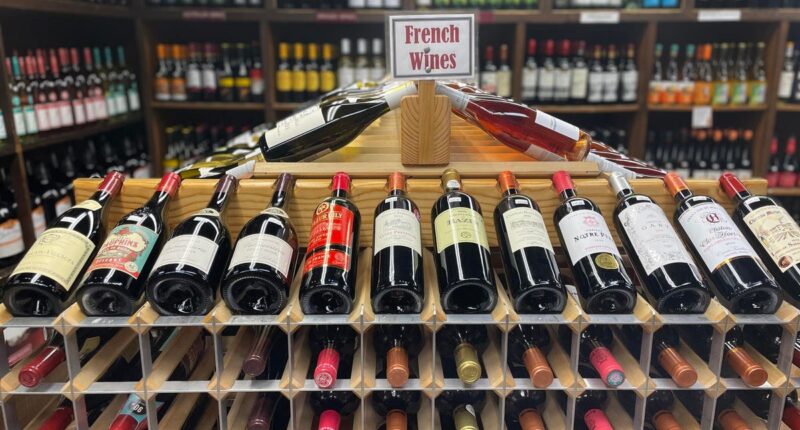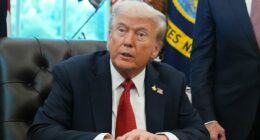Share this @internewscast.com
French wines like these and other imported wines are subject to tariffs 90.77% of the time. (Photo by: Deb Cohn-Orbach/UCG/Universal Images Group via Getty Images)
UCG/Universal Images Group via Getty Images
If you bought a nice, imported bottle of wine recently, there’s a better than 90% chance it entered the United States only after paying a tariff, probably about 15%.
That six-pack of imported beer in the next aisle?
Only 7.32% of beer imports have been subjected to a tariff, according to the latest U.S. Census Bureau data, meaning there’s a good chance it entered tariff-free.
So, a toast – no, no, somehow that doesn’t feel right.
This is a look at 10 specific import categories and the impact of President Trump’s tariff wars. The first five have the highest probability of a tariff being required before entering the United States. That includes not only wine but imports of women’s dresses, jewelry with precious metals and several types of shoes.
The second five include cars, oil, motor vehicle parts, refined petroleum and medical equipment. Tariff payments on these imports are the largest. While this is little pushback on the first five, there is some here, from the automotive industry and the energy companies.
Before we get to the specific categories, I should mention that Iam not going to address one non-specific import category, the only one that appears on both lists. It’s what the U.S. Census Bureau calls “low-value” shipments and was once largely the province of FedEx, UPS and other courier shipments valued at less than $800.
Today, these shipments are often online purchases, shipped to our doorsteps, the contents of their packaging often inscribed with Made In China. Because of their low value, little information was gathered or released about them. Former President Joe Biden was looking to reign in the so-called de minimis exclusion, in large part due to concerns about fentanyl and its precursors being shipped into the United States, and President Trump has now eliminated it.
One final note about the specific imports. I limited this analysis to the top 100 import categories from among more than 1,200. These 100 have accounted for three-fourths of total U.S. imports this year.
And one final note about tariffs and their impact, about which I have written previously. The total tariff value paid through July was 9.47% of all U.S. imports, according to my analysis. That’s the second-highest total going back decades, second only to the 10.03% rate in June. In March, one month before President Trump kicked off the trade war with the world, the rate was 2.38%.
A lingering question on the minds of many is, “Where is the inflation that was supposed to accompany tariffs?”
There are a number of factors in this, of course. But just one is that many tariffs that Trump has threatened are not yet being paid for one reason or another – and might never be, depending on the outcome of negotiations with countries, changes of heart and Supreme Court decisions.
Among those tariffs threatened but not yet being collected are those on the top three U.S. import trade partners, Mexico, Canada and China, which alone account for 35.66% of the total this year.
Let’s get back to the wine (HS 2004) and the rest of the lists.
European wines and many others subject to tariffs are responsible for 90.77 of all wine imports being hit with a tariff this year.
ustradenumbers.com
Wine tariffs
The reason the likelihood of your bottle of imported wine having been hit with a tariff is so high is because more than 80% of all U.S. wine imports come from France, Italy and a host of other European countries. The European Union, as you might recall, was among the first to agree to a baseline tariff of 15% with the United States.
Conversely, beer is so low because more than 87% of all beer (HS 2203) that entered the United States in July, the most recent government data available, came from one country: Mexico.
Why does that matter? Even though Trump has threatened 25% tariffs on Mexico, he quickly exempted anything that qualified for entry under the USMCA free trade agreement he negotiated in his first term – perhaps realizing the havoc that would be created if he didn’t announce the sweeping exemption. Mexico is the top source of U.S. imports, so a baseline tariff of 25% would have thrown a crippling punch at the U.S. economy.
For the same reason, the likelihood of your bottle of Mexican tequila being hit with a tariff is a fraction of the likelihood of that bottle of single malt whiskey from Scotland. The United Kingdom also agreed early on to a baseline tariff, in this case 10%.
Now for a few categories that might not make women too happy (or the men in their lives).
China and other Asian manufacturers have all agreed to increased tariffs or were already paying them. With 87.38 percent of all women’s dresses being hit with tariffs, it’s hard to imagine there won’t be price increases at the retail level.
ustradenumbers.com
Women’s dress tariffs
Dresses and women’s suits (HS 6204) stand a better than 87% chance of being hit with a tariff before entering the United States. Similarly, it’s where these imports originate that matters.
Vietnam and China are accounting for 36.91% of the total, with the former agreeing to a 20% U.S. import tariff and the later still subject to a 30% tariff. Bangladesh agreed to 20%, India is at 25% without an agreement, Indonesia and Cambodia both agree to 19%. A number of the tariff rates can be found at the Atlantic Council website.
India has yet to agree to a baseline tariff with the United States and, at this point, is subject to a 25% tariff.
ustradenumbers.com
Jewelry tariffs
Then there’s jewelry that includes precious metals (HS 7113), which almost certainly skews female but would include men’s jewelry as well. This would include rings, necklaces, bracelets, cuff links, earrings and the like. Through July, 72.72% percent of U.S. imports were subjected to a tariff.
The countries that are supplying these imports into the United Staes include four countries with about two-thirds of the total: India, which has a tariff rate of 25%; Italy and France, which combine for more than 35% of the total and are tariffed at 15%; and Thailand at 19%.
Vietnam has come to dominate U.S. shoe imports in recent years, including with leather shoes.
ustradenumbers.com
Women’s and men’s shoe tariffs
And what’s a nice new dress, a shiny necklace and earrings without a nice new pair of shoes? Shoes – for men and women, girls and boys – face a high likelihood of being hit with a tariff regardless of whether they are, for example, leather dress shoes (HS 6403, 84.24% likelihood), rubber athletic shoes (HS 6402, 89.23%), or running shoes with fabric “uppers” (HS 6404, 83.34%). These will involve imports from a number of countries but China and Vietnam are the two prime players. (I realize I “overstepped” and went with six imports but I wanted to include all three of these footwear categories.)
Let’s look at the five where the value of the tariffs collected is the greatest.
The “carve out” for USMCA partners for Mexico and Canada really shows up in passenger vechile imports, keeping the percentage of imports hit with tariffs relatively low.
ustradenumbers.com
Passenger vehicle tariffs
First up is passenger vehicles (HS 8703). While the percentage that is being taxed is relatively small compared to those of the first list of five, the 52.37% subject to tariffs is equal to $57.93 billion through June. The percentage is low because of the 37.62% from Mexico and Canada, all are exempt from tariffs, if they are USMCA compliant. (This depends on, for example, the percentage of the parts that originate in one of the three USMCA countries.)
But certainly, passenger vehicles from Japan, South Korea and Germany and other nations are being hit with tariffs. It’s an attempt to boost the fortunes of U.S. automakers and their workers. But separate tariffs on U.S. imports of steel and aluminum – important content in U.S.-manufactured vehicles, makes that a challenge. In addition, numerous foreign automakers operate in Mexico and Canada while essentially all the major foreign automakers manufacture in the United States, largely in the South.
Oil tariffs
Tariffs on oil (HS 2709) are hitting an even smaller 33.20% of all oil imports. But the total is $28.11 billion. It’s a particularly low percentage because Canada is accounting for more than 60% of all imports of foreign oil this year – and exempted from the proposed 35% tariff – while Mexico accounts for another 6.44% – and is also exempted.
Mexico and Canada, along with the United States are part of the world’s most sophisticated supply chain — that of the automotive industry. Because of USMCA compliance, many of these parts have not been required to pay a tariff through July.
ustradenumbers.com
Motor vehicle part tariffs
Tariffs in the major category of motor vehicle parts (8708) are totaling $25.55 billion through July, with 52.67% of all imports subjected to tariffs. With 55.68% coming from Mexico and Canada and presumably largely being exempt under USMCA compliance, the $25.55 billion will largely be coming from China, Japan and South Korea.
Refined petroleum tariffs
The value of refined petroleum (HS 2710), which includes gasoline as well as other fuels, subjected to tariffs before entry into the United States $15.48 billion. That is equal to 55.51% of the total, with imports from Canada and Mexico keeping the percentage in check.
Medical equipment tariffs
Finally, tariffs on medical equipment (HS 9018) are totaling $26.52 billion so far this year. The percentage of imports subject to a tariff payment is 31.09%. This category runs the gamut from syringes and catheters to MRI and EKG machinery.
In conclusion
Navigating the world of tariffs since President Trump’s April 2 “Liberation Day,” when he first laid out specifics for his trade war with the world, is complicated by a host of factors. Some tariffs are announced but not implemented. Some tariffs are paused. Some are increased and some are decreased. But there’s little doubt that the overall tariff rate has quadrupled this year and that the percentage of specific imports subjected to tariffs is quite often dependent on the originating country.











